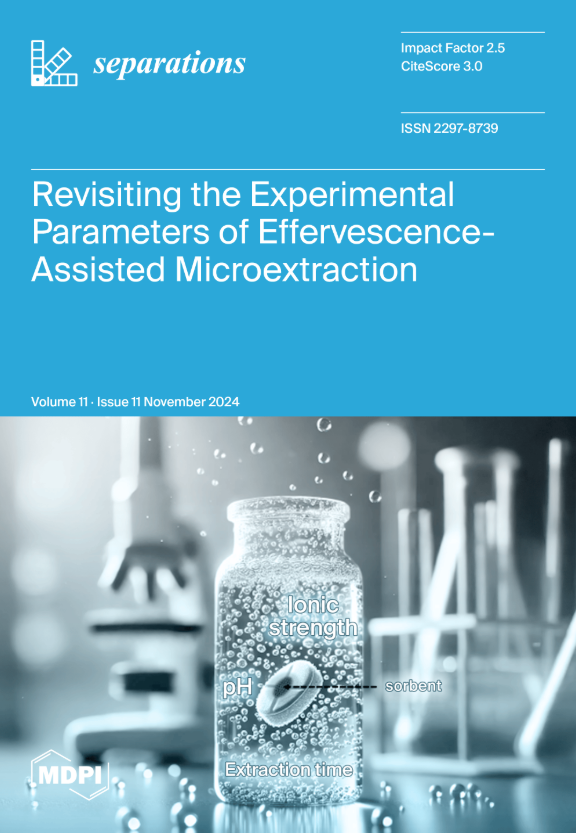磁性三维石墨烯固相萃取-气相色谱-质谱联用分析多环芳烃
IF 2.7
4区 工程技术
Q3 CHEMISTRY, ANALYTICAL
引用次数: 0
摘要
本研究制备了一种由三维石墨烯气凝胶和氧化铁纳米颗粒(3DG/Fe3O4)组成的复合材料,并通过气相色谱-质谱/选择离子监测(GC-MS/SIM)分析,将其用于13种多环芳烃(PAH)化合物的磁固相萃取(MSPE)。合成的吸附剂进行了一系列表征技术,包括扫描电子显微镜、振动样品磁强计、拉曼光谱、x射线衍射、布鲁诺尔-埃米特-泰勒、傅里叶变换-红外光谱和巴雷特-乔伊纳-哈伦达技术,以检查其性质和形态。合成的吸附剂结合了改性氧化石墨烯(GO)优越的吸附能力和磁铁矿微粒的磁性可分离性,从而具有高吸附容量,易于从样品溶液中分离。考虑了影响该方法的主要因素,采用中心复合设计(CCD)对该方法的效率进行了优化和建模。最佳条件为吸附剂用量为10 mg,提取时间为4 min,盐浓度为3% w/v。在最佳条件下,目标多环芳烃的检出限为0.016 ~ 0.2 ng mL−1,信噪比为3。线性动态范围为5 ~ 100 ng mL−1,决定系数(R2)为0.9913 ~ 0.9997。日内精密度和日间精密度的相对标准偏差(rsd)分别为3.9%和4.7%。该方法成功地应用于自来水、河流和雨水中多环芳烃的测定,回收率在71 ~ 110% (rsd <5.2%, n = 3)。本文章由计算机程序翻译,如有差异,请以英文原文为准。
Analysis of Polycyclic Aromatic Hydrocarbons Using Magnetic Three-Dimensional Graphene Solid-Phase Extraction Coupled with Gas Chromatography–Mass Spectrometry
In this study, a composite material consisting of three-dimensional graphene aerogel and iron oxide nanoparticles (3DG/Fe3O4) was created and utilized for the purpose of magnetic solid-phase extraction (MSPE) of thirteen polycyclic aromatic hydrocarbon (PAH) compounds via gas chromatography–mass spectrometry/selected ion monitoring (GC-MS/SIM) analysis. The synthesized adsorbent underwent a range of characterization techniques, including scanning electron microscopy, vibrating sample magnetometry, Raman spectroscopy, X-ray diffraction, Brunauer–Emmett–Teller, Fourier transform-infrared spectroscopy, and Barrett–Joyner–Halenda techniques, to examine its properties and morphology. The synthesized adsorbent integrates the benefits of superior adsorption capacity from modified graphene oxide (GO) with the magnetic separability of magnetite microparticles, resulting in a high adsorption capacity with easy separation from sample solutions. The efficiency of the proposed method was optimized and modeled using a central composite design (CCD), which considered the primary factors influencing it. The optimal conditions were obtained as the adsorbent dosage of 10 mg, the extraction time of 4 min, and the salt concentration of 3% w/v. The limit of detection for the target PAHs was established to range from 0.016 to 0.2 ng mL−1 in optimal conditions, exhibiting a signal-to-noise ratio of 3. The linear dynamic range spanned from 5 to 100 ng mL−1, with determination coefficients (R2) ranging from 0.9913 to 0.9997. The intra- and inter-day precisions were calculated as relative standard deviations (RSDs) equal to 3.9% and 4.7%, respectively. The proposed method was successfully applied to the determination of PAHs in water samples (tap, river, and rainwater), and recoveries in the range of 71–110% (RSDs < 5.2%, n = 3) were obtained.
求助全文
通过发布文献求助,成功后即可免费获取论文全文。
去求助
来源期刊

Separations
Chemistry-Analytical Chemistry
CiteScore
3.00
自引率
15.40%
发文量
342
审稿时长
12 weeks
期刊介绍:
Separations (formerly Chromatography, ISSN 2227-9075, CODEN: CHROBV) provides an advanced forum for separation and purification science and technology in all areas of chemical, biological and physical science. It publishes reviews, regular research papers and communications. Our aim is to encourage scientists to publish their experimental and theoretical results in as much detail as possible. There is no restriction on the length of the papers. The full experimental details must be provided so that the results can be reproduced. There are, in addition, unique features of this journal:
Manuscripts regarding research proposals and research ideas will be particularly welcomed.
Electronic files and software regarding the full details of the calculation and experimental procedure, if unable to be published in a normal way, can be deposited as supplementary material.
Manuscripts concerning summaries and surveys on research cooperation and projects (that are funded by national governments) to give information for a broad field of users.
The scope of the journal includes but is not limited to:
Theory and methodology (theory of separation methods, sample preparation, instrumental and column developments, new separation methodologies, etc.)
Equipment and techniques, novel hyphenated analytical solutions (significantly extended by their combination with spectroscopic methods and in particular, mass spectrometry)
Novel analysis approaches and applications to solve analytical challenges which utilize chromatographic separations as a key step in the overall solution
Computational modelling of separations for the purpose of fundamental understanding and/or chromatographic optimization
 求助内容:
求助内容: 应助结果提醒方式:
应助结果提醒方式:


